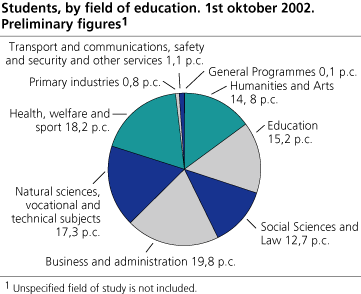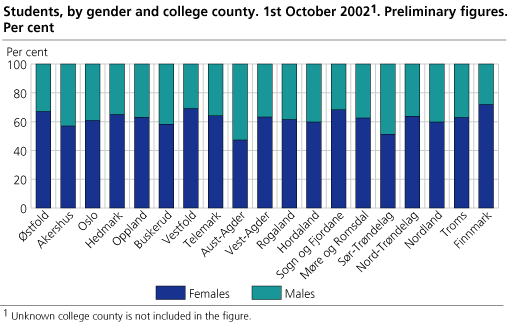Content
Published:
This is an archived release.
6 out of 10 students are female
The proportion of female students at Norwegian universities and colleges continues to rise. Roughly 42 000 more women than men were registered in higher education by 1 October 2002. Female majority is a fact at almost all universities and colleges. In total, 60 per cent of all students in higher education are female.
Increased number of students at most institutions
The total number of students increased from 1997 to 2002. When looking at all universities together, there was a decrease in the number of students from 1997 to 2001, but the numbers climbed again in 2002. The universities in Oslo and Bergen had fewer students in 2001 than 1997, however more students registered in 2002 than 2001. The Norwegian University of Science and Technology had a climbing number of students during the whole period, while the University in Tromsø had a drop in the number of students in both 2001 and 2002.
Nearly all colleges registered more students in 2002 than in 1997. Every university and college had a higher number of students in 2001 than in 1997, except for the military colleges that had a declining rate of students. Most colleges also had an increased number of enrolled students from 2001 to 2002, except for the colleges at Lillehammer, Telemark, Molde, Narvik, Nesna and Finnmark. The Sør-Trøndelag University College experienced the highest increase of new students, with more than 2 600 new students in the period from 1997 to 2002.
The rise in the number of registered students at the Norwegian School of Management is due to the inclusion of so called ' business courses', which normally comprises small subjects organised to suit wage earners rather than full time students. The share of students registered at 'business courses' were approximately 8 000 in 2002.
Female majority
By autumn 2002, 41 743 more women than men were registered in institutions for higher education. The proportion of female students is now at 59.8 per cent, against 57.6 per cent in 1997. A majority of the new entrants in 2002 were women. Most universities and colleges had a majority of female students in 2002, except for the Norwegian University of Science and Technology, the Norwegian School of Economics and Business Administration, Narvik College and the group of 'Other colleges'.
Even distribution among the different fields of education
By 1 October 2002, a majority of the students were registered within business and administration. This is partially due to the high number of students registered at 'business courses' at the Norwegian School of Management. Health, welfare and sport had the second largest number of students, closely followed by natural sciences, vocational and technical subjects. Primary industries and transport, safety and security had the lowest number of registered students.
Few geographical differences
Almost every county had an increase in the number of registered students from 1997 to 2002. Oslo however, had a declining number of students from 1997 to 2001. Aust-Agder, Nordland and Finnmark had fewer students in 2002 than in 2001.
Tables:
- Table 1 Students, by gender, type of college, ownership and educational institution. Preliminary figures. 1st October. 1997, 2001 and 2002
- Table 2 Students, by age and type of college. Absolut figures and per cent. Preliminary figures. 1st October 2002
- Table 3 Students, by gender and field of education. Preliminary figures. 1st October 2002
- Table 4 Students, by gender and college county. Preliminary figures. 1. October. 1997, 2001 and 2002.
This page has been discontinued, see Students in higher education, Annually.
Contact
-
Geir Nygård
E-mail: geir.nygard@ssb.no
tel.: (+47) 48 15 13 44
-
Maj-Lisa Lervåg
E-mail: maj-lisa.lervag@ssb.no
tel.: (+47) 45 68 84 72


